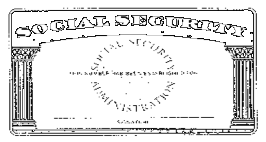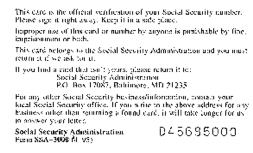Report to Congress on Options for Enhancing the Social Security Card
CHAPTER III - THE CURRENT SOCIAL SECURITY CARD
DESCRIPTION
The current Social Security card consists of specially designed pre-printed banknote paper bearing the words, "Social Security," and the official seal of SSA. The statement, "This number has been established for" is printed across the official seal, in the middle of the card. During the card issuance process, the SSN and the number holder's name are impact printed above and below this statement on card printing equipment operated by SSA.
 |
 |
A signature line and the word "Signature" are preprinted across the bottom of the card, and there is blank space above the signature line for the number holder's signature. Social Security cards issued to certain noncitizens bear the legend, "Valid For Work Only With INS Authorization." Some other noncitizens have cards with the legend, "Not Valid for Employment." When applicable to a particular Social Security card, these legends also are impact printed during the card issuance process.
The back of the card contains information about the SSN and the card itself, including where to mail found cards, where and how to obtain information from SSA, a card stock sequence number, and the card's official form number.
SECURITY FEATURES
Section 205(c)(2)(G) of the Social Security Act (as amended by section 345 of P.L. 98-21)
required prospectively that new and replacement Social Security cards be made of banknote paper and (to the maximum extent practicable) be a card which cannot be counterfeited. SSA consulted with the Bureau of Engraving and Printing, the Government Printing Office, and the Secret Service regarding the anti-counterfeiting features to be incorporated in the new card. Since October 1983, the current card incorporates these and a number of other security features appropriate to a paper card format, such as:
- The stock is a blue tint marbleized random pattern. Any attempt to erase or remove data is easily detectable because the tint is erasable. The words "Social Security" are printed in white.
- Planchettes (small multi-colored discs) are randomly placed on the paper stock and can be seen with the naked eye. These yellow, pink, and blue discs can appear anywhere on the card, including the area on the card that contains the seal and identifying information.
- Intaglio printing of the type used in U.S. currency is used for some areas on the front of the card. Intaglio printing on the card provides a "raised effect" and abrasiveness that can be felt when examined by touch. This printing technology is not widely available and is difficult to replicate.
- Other security features not obvious to the naked eye are not publicized
Because of the SSA workload and burden on the public of replacing all cards still in use, SSA does not issue replacement cards whenever new security features are added or a new version of the card is approved. Thus, there are now 47 valid versions of the Social Security card in use; a large number of which are pre-1983 versions without counterfeit-resistant and tamper-proof security features.
CARD USAGE AND DURABILITY
The Social Security card reliably serves only as official verification of the SSN assigned by SSA to the person whose name is on the card. The card is not proof of the bearer's identity or citizenship/noncitizen status, and has no transaction or data storage capability. Employers are advised to use the Social Security card to obtain an employee's correct name and SSN when first recording such information for wage reporting purposes.
Employers, however, do not have the legal authority under the Social Security Act to require an employee to show his or her Social Security card. Neither the Social Security Act nor Social Security regulations require presentation of the Social Security card to conduct business with SSA.
The current Social Security card is capable of performing its intended function throughout the lifetime of the number holder. Banknote paper Social Security cards with little use or handling are expected to last at least 50 years. Cards with moderate use or handling are expected to last 35 to 50 years. Although SSA issues approximately 10 million replacement Social Security cards annually, this volume is the result of lost or damaged cards, or the need to change the name appearing on the card, rather than card fatigue.
TYPES OF CARDS ISSUED
Originally, SSA issued the same type of Social Security card to everyone. In May 1982, SSA began printing the legend, "NOT VALID FOR EMPLOYMENT," on the Social Security cards of noncitizens not authorized to work. This legend was added because of the increasing need for people to have SSNs for nonwork purposes, such as reporting taxes to IRS, and INS concerns that unauthorized people could use their SSNs for work. Since IRS began assigning taxpayer identification numbers to noncitizens for tax purposes when the noncitizen does not meet the requirements for an SSN, there are only a few valid reasons for issuing a nonwork Social Security card. One such reason to issue a nonwork SSN, is to receive Federal benefits. A card with the legend,"NOT VALID FOR EMPLOYMENT," is not acceptable evidence of employment eligibility under IRCA.
On September 14, 1992, SSA began printing the legend "VALID FOR WORK ONLY WITH INS AUTHORIZATION" on cards issued to noncitizens lawfully in the U.S. with temporary authority to work. In these cases, employers must look at the noncitizen's INS document to determine if the noncitizen has current authorization to work in the U.S.
See Appendix D for a description of the types of cards.